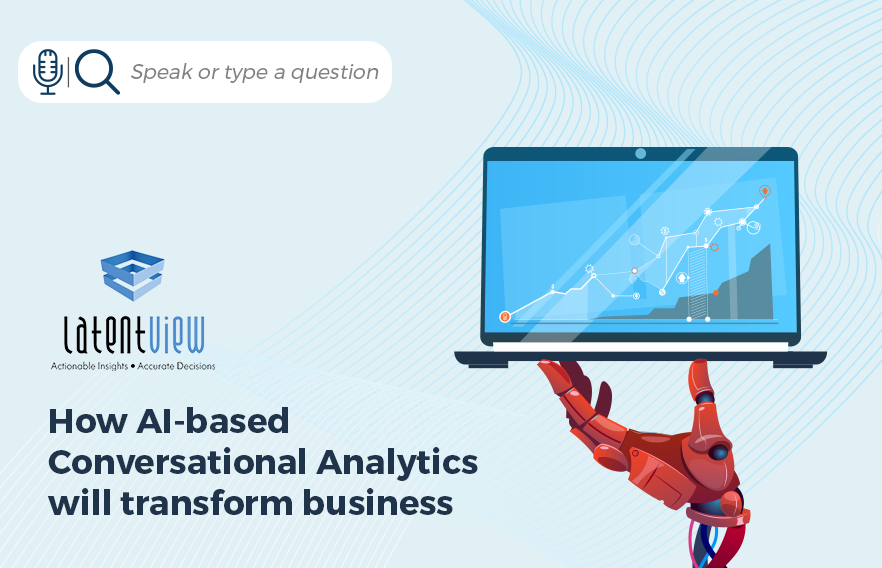“Alexa, order paper towels…” Ten years ago, the idea of purchasing products on demand from home through a speaker was still in the realm of science fiction. Today, voice-enabled devices like Alexa and Google Home have made this a reality. The mobile-first era placed the world at our fingertips. In this new conversational age, our voices are playing a greater role in how we access information and complete everyday tasks.
While conversational systems have changed how consumers do things like buy paper towels, these systems are also well positioned to transform enterprise IT and the way people within organizations access and interact with data. Conversational systems that leverage natural language interactions are already considered a main driving force for an IT paradigm shift. According to Gartner, by 2021, “conversation first” will be adopted by the majority of enterprise IT organizations as the most important new platform paradigm, superseding “cloud first, mobile first.”
Conversational AI is here, and there’s a lot of momentum, but what’s driving this, and what are the opportunities and benefits for enterprises? First, let’s take a quick step back and discuss a few basic definitions.
What is Conversational Analytics?
In order to understand conversational analytics, we first have to talk about data. Enterprises have a vast amount of data – in fact, most are swimming in oceans of both structured and unstructured data about their consumers and competitors. This data is streaming in nonstop from multiple sources and being stored in various systems across the business. In simplest terms, conversational analytics is the use of AI to sift through data, extract the right needles from multiple haystacks, and make it accessible through voice queries.
Think about the data involved in a consumer ordering paper towels through Alexa. Data is what makes that experience so seamless – from the moment you give the voice command, to when the paper towels show up at your doorstep. Your shipping address, your default payment method, whether you’re an Amazon Prime member, whether you’ve set to re-order a specific brand and quantity, and so on. For enterprises, there’s a lot of varying data that goes into something common like a market share report. In fact, there’s likely relevant data that could be included in such a report, but that goes untapped. AI-based conversational analysis has the potential to change that.
Factors Driving the Rise of Conversational Analytics
There are many advancements in technology pushing conversational analytics forward, specifically for enterprise use. Here are a couple of main factors.
- Advancements in AI: Artificial Intelligence as an umbrella term continues to evolve rapidly. While AI spans a lot of ground, especially relevant to this topic are advancements in AI for the intelligent workplace. As mentioned, voice-based conversational systems such as Alexa and Siri are already commonplace in the consumer world. It’s only natural that business leaders would also expect to see similar intelligent conversational systems at the workplace.
For example, while chat bots were initially employed to listen in and provide calls-to-action for one-off customer service issues, advancements in AI have moved things forward where chat bots now have a place in a far bigger, organization-wide strategy, which uses these chat bots for business process automation, cost savings and empowering teams with additional and more granular insights.
- Advancements in Natural Language Processing: NLP, in a nutshell, is using computers to understand human language. According to Machine Learning Engineer, George Seif in a Medium post, “Natural Language Processing (NLP) is a subfield of Artificial Intelligence that is focused on enabling computers to understand and process human languages, to get computers closer to a human-level understanding of language.” The reason NLP is so challenging is because human language is inherently full of nuance – from sarcasm to slang – and unstructured data from both voice and text in social media, for example, is very hard to interpret correctly through voice analytics.
There have however been good advancements made in NLP to where context, sentiment, emotion and other factors are being understood more accurately by machines. There have been exciting advancements in NLP in the field of robotics, especially combined with computer vision. Conversational analysis depends heavily on NLP for obvious reasons, as human to machine verbal queries and commands must be properly understood and interpreted to ensure the right result.
Why Conversational Analytics Will Transform Businesses
The main reason that AI-based conversational analytics systems will radically transform business ties back to the issue of data. Lack of data is not a problem most enterprises face today. In fact, it’s the exact opposite – most have an overabundance of data but lack the resources and technology to harness it. As a result, data, which could be useful, instead stays dormant. There are two main benefits for businesses that the increased use of conversational AI will provide across the enterprise.
- Democratization of Data: Going back to the consumer example of using Alexa to order products: this iteration of voice technology has just made it even easier to complete the chore of buying everyday items. Before voice-enabled technology, or even the internet, the task of buying paper towels was already democratized. There were no special skills needed to drive or walk to the corner store or supermarket and buy a roll of paper towels. In the business world however, accessing and getting back user-friendly insights from massive amounts of data traditionally required special skills. Data in the enterprise hasn’t been accessible to everyone in the organization. Normally the people with coding skills, the statisticians and analysts were the gatekeepers of data. AI-powered conversational analysis platforms can break down the barriers and provide the everyday business practitioner – from the CEO to a marketing manager – with a way to interact with data in an accessible system using natural language.
This is increasingly essential as most companies simply don’t have the human resources for the old paradigm. There is already a shortage of data scientists and this problem will only get worse. Research shows there is both a growing demand and growing shortage of data scientists. Imagine a CEO being able to say to an AI-powered conversational system: “Give me my weekly market share update,” or a VP of marketing: “How did last week’s new direct marketing campaign perform?” and receive back a report or answer instantly based on all available data in the system. The power for anyone in the company to access and leverage data on demand by voice in natural language has the potential to open the floodgates, increasing both effectiveness and efficiency.
- Standardization of Data Reporting and Insights: A well codified AI conversational interface or app helps ensure consistency and accuracy of data reporting and insights enterprise wide. Because companies have people across the organization with varying technical capabilities and incentives to have data fit their own agenda or align with desired outcomes, data can often be misrepresented. As a result, inaccurate conclusions and erroneous decisions are taken by management who do not have the time or expertise necessarily to understand the flaws in the data.
When data is standardized in one system and accessible to all, a C-suite executive can easily ask the system for a market share report and for the factors that drove share performance, without having to wait for an analyst being constrained by analyst capacity. Insights are quickly surfaced, and ultimately voice assistants could also be set up to provide intelligent feedback (suggest actions based on the data nuggets pulled from the massive data sets).
With machine-learning trained systems gaining the ability to make sense of speech, automated chat bots are now being used increasingly across enterprise applications. They have found their place in a far bigger, organization-wide strategy which uses them for business process automation, cost-savings and empowering teams with additional and more granular insights. Aside from giving you information, the right enterprise chatbot solution goes beyond just answering questions posed– it recommends insights that other business teams are looking for, helping you find new lines of inquiry. To understand how LatentView Analytics can help you democratize data in your enterprise and get faster time to insights, please contact: marketing@latentview.com




